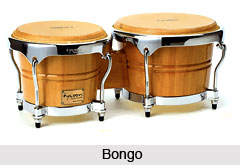 Bongo is a percussion instrument belonging to the family of cylindrical drums with one drumhead. The Bongos are essentially Cuban in origin and play an important role in the Latin American dance orchestra. With its high, crisp, and varied sound, it adds spice to the rhythm section.
Bongo is a percussion instrument belonging to the family of cylindrical drums with one drumhead. The Bongos are essentially Cuban in origin and play an important role in the Latin American dance orchestra. With its high, crisp, and varied sound, it adds spice to the rhythm section.
History of Bongo
Bongos have originated in Africa and are very much a part of the South American musical culture. They were brought to South America by African slaves who played three drums. These three drums were called bonko in their homelands of Cameroon and Nigeria. The Abakua, a musical fraternity formed by a group of Afro-Cuban males, made use of the bonko drums. It is believed that these bonkos have influenced the creation and playing of the bongos on the South American continent.
Design of Bongo
The Bongo is approximately eight inches high with an eight-inch diameter. The original bongo, imported from the Caribbean, had an indefinite pitch. Later forms have tension screws with which the drumhead can be tuned. The tonal range of the bongo ranges from c minor to c sharp.
In South American dance orchestras, it is largely played in paired sets. They consist of a pair of single-headed, open-ended drums attached to each other. The frames (frequently of unequal height) are attached to each other with a crossbar, and one drum will be tuned high while the other is tuned low.
The drums are of different sizes: the larger drum is called hembra (female) in Spanish and the smaller is known as the macho (male). The crossbar or bridge is manufactured using oak or mahogany with alloy rims and lugs. Most Bongos are manufactured from wood, though fibreglass models are also available. The drumhead of bongos is made using animal skin.
Playing and Sound of Bongo
Bongo is most often played by hand and is especially associated in Cuban music with a steady patter or ostinato of eighth-notes known as the martillo or "hammer". The instrument is usually gripped between the knees. The drumhead is struck with the fingers or the palm, although some contemporary compositions require drum sticks. Small variations in pitch are produced by stretching the drumhead with the thumbs. Bongo drums produce relatively high-pitched sounds. Bongos can also be muted by placing part of the hand on top of the head while striking it. In Cuban music, bongos are usually played by the same musician as the cowbell (Spanish: cencerro). These drums can also be played on a stand, as is the case with concert orchestras and bands.
Popularity of Bongo
Though most popular in Latin American dance, a bongo can occasionally be found in the modern symphony orchestra because a few composers, mainly South Americans, such as the Mexican Carlos Chavez (1899-1978), have included the bongo drums in their scores. Bongo drums were also introduced into North American jazz and popular music in the mid-twentieth century.
Renowned Performers who use Bongo
There are various musicians who are popular for Bongo. Among them who deserve special mention are Septeto Nacional and Sexteto Habanero. Artists such as Ricky Martin also use the bongo drum in music.




















